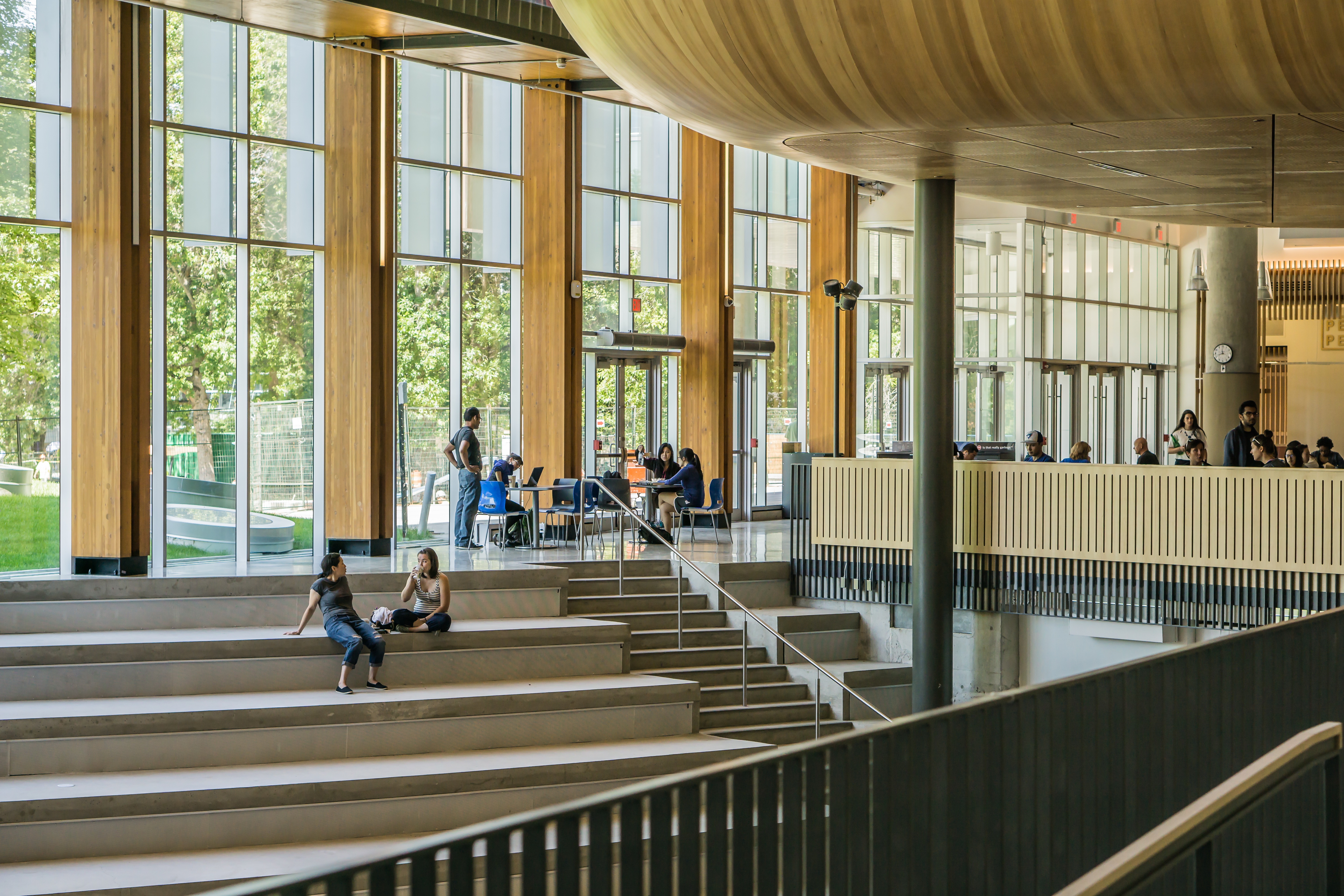The higher education sector consists of over 4,000 private and public colleges, educating more than 20 million students annually. Colleges and universities have the power to strengthen local communities and economies by teaching both older and younger generations valuable marketable skills; fostering values, morals, and civic traits; introducing career opportunities, and creating local jobs. The higher education industry, however, continues to experience rising energy and tuition costs, making it a challenge to provide safe, comfortable, and engaging environments for faculty and students. To mitigate costs, colleges and universities have turned to energy efficiency, and today, many are leaders in advancing sustainable practices. The advocacy for and application of energy efficiency is so prevalent that The Princeton Review even publishes its own Guide to Green Colleges. Despite these powerful driving forces, however, many energy efficiency improvements are ignored due to budget constraints and other barriers. The following will examine growth, budget, and priority challenges that are suspending critical higher education energy efficiency projects from moving forward.
Space and Energy Growth
According to the U.S. Department of Energy, the higher education sector spends approximately $14 million on energy costs in the U.S. annually. Enrollment rates are on the rise, challenging higher education institutions to find ways to meet the needs of a growing student body while simultaneously keeping costs down. According to Sightlines research, private and public campus sizes have grown by 10 percent since 2007, increasing the overall energy output per campus. While newer buildings are developed with updated and more energy efficient building codes, lighting, HVAC, and other mechanical technologies require continuous maintenance and improvement to ensure optimal energy and cost reductions.
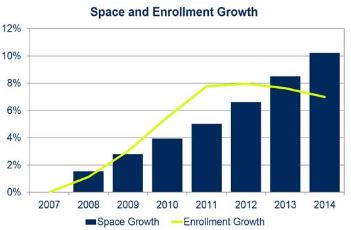
Budget Challenges
Budgets are a challenge for any business, and higher education is no exception. A 2010 Siemens study concluded funding was the biggest challenge to energy efficiency improvements followed by management approval.
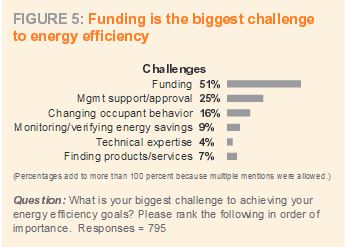
In recent years, higher education institutions have also struggled with budget cuts. According to a new data from the Center on Budget and Policy Priorities, every U.S. state has seen a decline in budgets per student since 2008. Massachusetts—one of the nation’s higher education hubs—has seen a 16% drop in per-student funding. The worst hit is Arizona, which has seen a 56% decline.
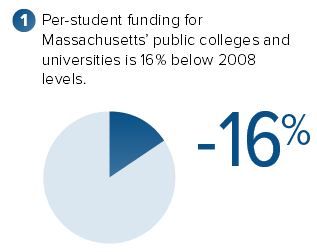
A 2010 McKinsey & Company research further details the budget-to-energy dilemma:
“. . . payback times, capital constraints, and procurement can be problematic . . . . Many companies now require a one-and-a-half- to two-and-a-half-year payback, although even a two-and-a-half-year timeline cuts the sector’s potential by only 46 percent. Managers may ignore attractive energy-efficiency projects because companies fear to hurt their credit ratings by raising debt. Fear also causes risk-averse plant managers to replace failing equipment with the same models rather than more up-to-date and energy-efficient ones—but inventory-carrying costs prevent many distributors from offering them anyway. And even many industrial-procurement operations focus on upfront rather than total costs.”
Higher Education Energy Efficiency Priorities
Most facility managers understand the cost-benefit analysis of energy efficiency investments. EPA research shows that “. . . facilities that implement energy conservation measures outperform their competitors by as much as 10 percent in net operating income.” That may be why a study conducted by Schneider Electric and the Alliance to Save Energy that surveyed more than 150 higher education institutions about their future plans for energy efficiency found that “Ninety-six percent of respondents view energy efficiency as important to fulfilling their school’s core mission. More importantly, “86 percent plan to increase or maintain their investments in energy efficiency, indicating it as the most cost-effective way to meet their energy needs.” Yet, restrictive budgets have a way of unhinging vital energy efficiency improvements, whereby capital is funneled into only what the institution believes are the most important upgrades. The Campus Technology graph below depicts the importance of energy efficiency measures.
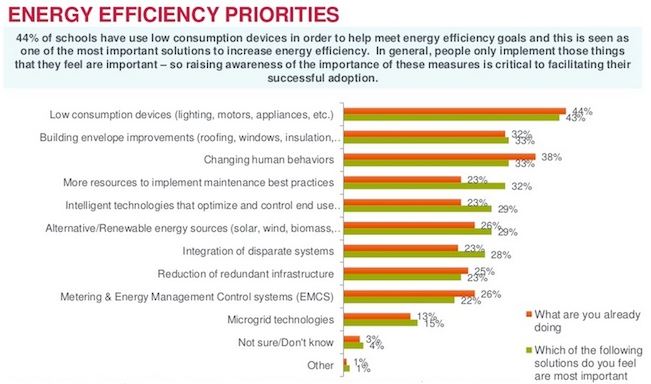
Besides building envelope improvements, which is a more important issue for higher education buildings than most commercial or industrial organizations, higher education prioritizes similar energy efficiency improvements: lighting and HVAC retrofits. Budget and management constraints put only the low-hanging fruit on the table and leave many other and cost-saving energy efficiency improvements out of the discussion.
Energy & Financial Sustainability
According to the National Association of Independent Schools (NAIS), colleges and universities are experiencing what it describes as the “new normal.” The new normal philosophy has developed due to the severity of tuition hikes, making it increasingly difficult for students to pay for higher education. The new normal model is calculated by determining the tolerance for tuition increases and establishing a base price. Once the price is set, “a strategic assessment begins on how to increase non-tuition revenues and decrease costs without sacrificing quality or core programming.” Energy efficiency serves this exact purpose.
What may be more important is that students today have embraced sustainability. The Association for the Advancement of Sustainability in Higher Education (AASHE) details a study performed by The Princeton Review that asked over 10,000 students how sustainability would affect admissions. Almost two-thirds indicated that it could impact their decision to apply or attend the school, and 23 percent indicated it would “strongly” or “very much” impact their decision. The article also cites a different study conducted by the College of William and Mary, which found that “current freshmen are two times more likely to choose their school based on sustainability concerns than the entering freshman classes just 3 years ago.” Higher education energy efficiency has shown to be a differentiator.
According to a study by Bain & Company, differentiation is critical to the ongoing success of higher education institutions. “. . . The worst case scenario for an institution is to be relatively expensive and completely undifferentiated. Who will pay $40,000 per year to go to a school that is completely undistinguished on any dimension?” The same study cites that a school may experience financial instability if “Your property, plant, and equipment (PP&E) asset is increasing faster than your revenue.”
The Importance of Breaking Barriers
When colleges and universities are able to take advantage of a comprehensive suite of energy efficiency applications, enormous savings can be achieved. Northeastern University, for example, has implemented over 60 energy efficiency projects over the years as part of its Climate Action Plan, including “high-efficiency lighting and controls, chillers, rooftop HVAC units, variable speed drives, and electronically commutated motors (ECM).” By breaking barriers and moving beyond the low-hanging fruit, Northeastern University has saved over $1 million dollars in energy costs.
Prism Energy Services also works as an instrumental advisor and implementer of higher education energy efficiency solutions, having worked with numerous public and private schools in New England, including MIT, Clark University, Bentley University, Bridgewater State University, and others. Recently, Prism completed a job on Boston University’s Engineering Library, saving the library just under $20,000 a year on its energy costs.
Bottom Line
Budget cuts are a continuing struggle for higher education institutions, but with growing student bodies and campus sizes, the amount of energy consumed in both public and private institutions will continue to increase. Higher education energy efficiency is a solution to minimizing costs, alleviating budget constraints, and providing market differentiation. New generations of students expect more out of their college experience. Higher education energy efficiency proves to be a viable solution. Those that take energy efficiency seriously and go beyond low-hanging fruit improvements will differentiate themselves in the marketplace have a higher likelihood of increasing financial stability and experiencing higher student enrollment rates.




